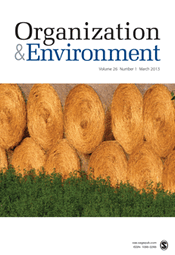Back to Reality: Environment Is More Than An Issue
Editor’s note: We are pleased to welcome Pratima Bansal of the University of Western Ontario and Janelle Knox-Hayes of the Georgia Institute of Technology, whose paper “The Time and Space of Materiality in Organizations and the Natural Environment” was published in the March 2013 issue of Organization & Environment.
The invitation to contribute to the inaugural issue of Organization & Environment for the new editorial team presented us an opportunity to push forward ideas that we had been discussing for several years. The editors  encouraged us to be bold, so we were able to describe issues that we believe are critical to the future of organizations and environment research.
encouraged us to be bold, so we were able to describe issues that we believe are critical to the future of organizations and environment research.
The core argument in this article is that physical materiality, as reflected in the natural environment, is fundamentally different from the sociomateriality that comprises organizations and markets. Time and space are more easily compressed in the sociomateriality of organizations, than in the physical environment.
 We argue that the time and space compression of organizations has contributed to many environmental issues. For example, the accelerating speed of new generations of computing equipment is taking a toll on the natural environment, such as climate change. We call for more explicit attention to time and space in organizational studies, in order to manage the relationship between organizations and the natural environment.
We argue that the time and space compression of organizations has contributed to many environmental issues. For example, the accelerating speed of new generations of computing equipment is taking a toll on the natural environment, such as climate change. We call for more explicit attention to time and space in organizational studies, in order to manage the relationship between organizations and the natural environment.
This work also has important policy implications. In particular, we suggest that policy instruments need to be connected to the temporal and spatial qualities of the issue being managed. Direct carbon regulation, therefore, is more effective than carbon markets in managing carbon, because it imposes controls on when and where the emissions occur. Carbon markets, on the other hand, are open to distortion.
Click here to read the paper, “The Time and Space of Materiality in Organizations and the Natural Environment,” in Organization & Environment.
 Pratima Bansal is the Canada Research Chair in Business Sustainability at the Richard Ivey School of Business, Western University, Canada. Her research focuses on aspects of time, space, and scale in organizations. She has published in the Academy of Management Journal, Organization Science, and Strategic Management Journal, among others.
Pratima Bansal is the Canada Research Chair in Business Sustainability at the Richard Ivey School of Business, Western University, Canada. Her research focuses on aspects of time, space, and scale in organizations. She has published in the Academy of Management Journal, Organization Science, and Strategic Management Journal, among others.
 Janelle Knox-Hayes is an assistant professor of economic geography at the Georgia Institute of Technology and a research associate at the University of Oxford department of geography and environment. Her research focuses on the institutional development of emissions markets in Europe, the United States and Asia. Her work has been published in journals such as the Journal of Economic Geography, the Annals of the Association of American Geographers, and Strategic Organization.
Janelle Knox-Hayes is an assistant professor of economic geography at the Georgia Institute of Technology and a research associate at the University of Oxford department of geography and environment. Her research focuses on the institutional development of emissions markets in Europe, the United States and Asia. Her work has been published in journals such as the Journal of Economic Geography, the Annals of the Association of American Geographers, and Strategic Organization.































































































